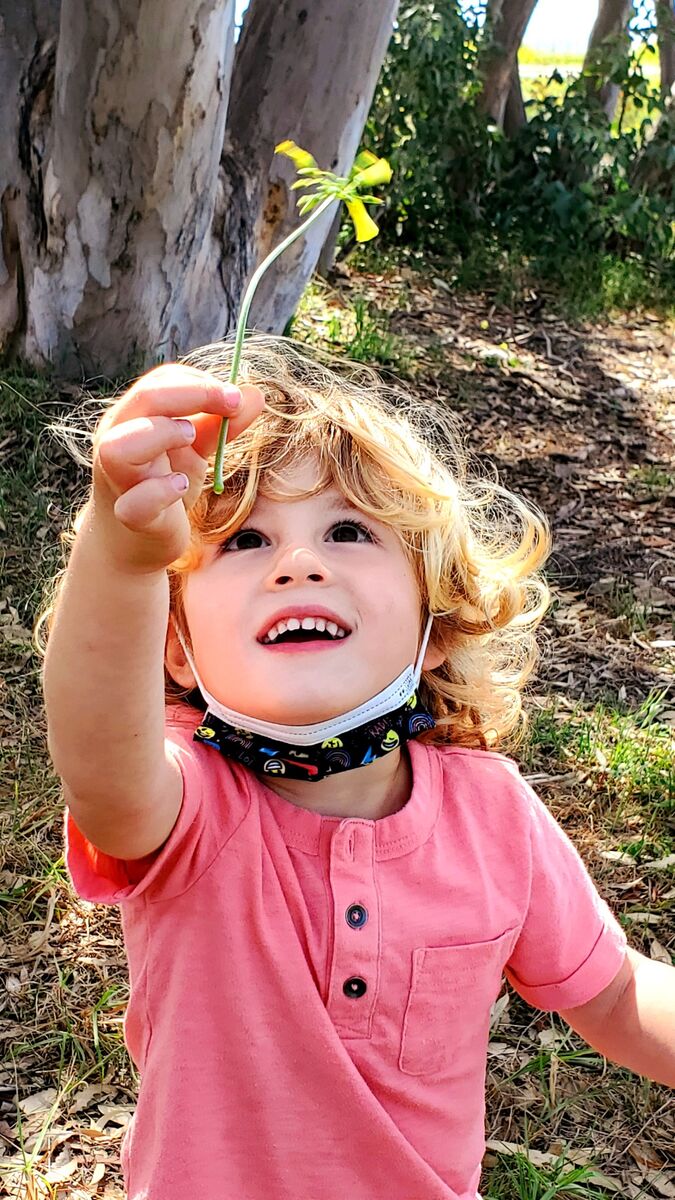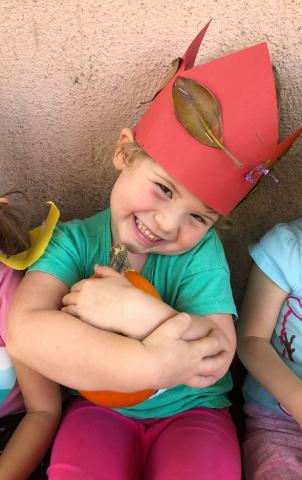
OFCC has six preschool classrooms that serve children aged three through five years.
We believe that children learn through self-discovery, hands-on exploration indoors and outdoors, and interaction with others; that these experiences will help them develop confidence in their own abilities; and that play is the primary medium for early learning.
Our curriculum emerges from the child's interests. Topics for study and project work come from children's experiences, conversations, questions and ideas. They are provided with many opportunities for authentic learning, discovery and investigation. Collaboration and small group work is supported by the staff who encourage exploration in an enriched learning environment.
Children have the opportunity to express their ideas and hypotheses in a variety of ways that include art experience, writing, construction, music and gardening. The larger the variety of ways children are able to express themselves the deeper their understanding grows. At all times the developmental level, natural affinities and the family and home environment of each child are considered.
For questions regarding the Preschool program:
Please contact Tamara Thompson, Preschool Program Coordinator, at 805-893-4904 or via email tamarat@ucsb.edu
Frequently Asked Questions
Full time: Monday - Friday
Part time: Monday/Wednesday/Friday or Tuesday/Thursday
Part time (am only): Monday - Friday (limited)
Curriculum at ECCES develops through an interactive process between the child, the teacher and the environment. In each classroom group, there is a balance between teacher-planned activities and those activities that emerge from the children's interests, abilities and needs. Our emergent curriculum is based on inquiry, problem-solving, discovery and application of key issues and concepts. It points to connections within and across disciplines characterized by project-based, authentic learning, allowing more in-depth study of topics arising from children's curiosity and queries.
We typically determine the placement of your child based on age; however, we consider many other factors upon deciding the make-up of a classroom. Such factors would include: boy to girl ratio, different personalities, age, readiness, social emotional development, whether a child still needs help with toileting, etc.
Children that are age eligible for transitional kindergarten or turn five years old between the months of September - February are placed in our older preschool classroom.
The toddler rooms, ages 2-3, have diaper changing facilities. The older classrooms, 3-5 do not have access to diaper changing facilities. Children who are just gaining competency (i.e. still occasionally having accidents), are welcome to work through that final phase with our nurturing and skilled staff.
Our educators are highly skilled in working with families and children on the transition process. We will share information with you during a scheduled intake conference before your child begins in a classroom to help get your family ready for the transition. As each child reacts individually to transitions, we work with families to develop individual plans for successful transitions to ECCES.
ECCES has an excellent adult-child ratio. We staff classrooms not just according to Title V licensing requirements, but to best-practice standards. Adult-child ratios are 1:8 in preschool classrooms.
All classrooms have two qualified early childhood educators in the classroom. In addition to these two primary teachers, classrooms have teaching assistants that are UC Santa Barbara students. We have support teachers when there is a need for additional help or when a teacher is absent.
In California, licensing regulations require that "all children shall be given the opportunity to nap or rest without distraction or disturbance from other activities at the center." Naptime is a warm and relaxing time of the day for children and caregivers. Children generally start their rest time between 12:30 and 1:30, and get up between 2:00 and 3:00, depending on the age group. All classes rest on mats. Nap bedding is sent home weekly to be laundered and brought back. Children who do not fall asleep after 20 minutes may do "quiet" work until the majority of children are up. Children who do not nap learn to remain quiet and respect others who are napping. Children who fall asleep are allowed to wake up naturally.

Routine and Schedule of Daily Activities
Teachers work together to plan indoor and outdoor schedules to ensure all children have access to various activities and environments throughout the day. The schedule is posted in the classroom. The Centers follow a daily routine that is adapted to the children's interests or needs. The length of time spent during one part of the day may change from one day to the next, but the pattern or order of events throughout each day is consistent and predictable. Children do best when there is a clear understanding or expectation of the daily routine.
Preschool Daily Schedule (3-4 years)
Arrival
7:30-8:30 - Children and parents are greeted by their teacher and children are encouraged to visit a classroom learning center or participate in a table activity. Depending on the time of arrival, children and parents will often use this opportunity to read a book together before their good-byes.
Classroom Project Work
8:30-9:30 - Children will work in small groups on a project of their choice. Teachers have also planned activities that will build upon skills and encourage children to explore ideas and concepts through open-ended materials and questioning. Projects can be extended in order to give children an opportunity to add depth and detail to their exploration and research. Through this open-ended balance of teacher/child-initiated learning, both teacher and child are researchers. Teachers use observation and documentation of children's work for both assessment and curriculum development.
Morning Snack
9:30-10:00 - Children are provided a nutritious snack. Teachers and children sit family style so that children can express ideas, use language, make plans, and practice good eating habits.
Circle Time/Planning
10:00-10:30 - The morning circle allows children and teachers an opportunity to come together as a whole group. The whole group experience offers children the opportunity to express ideas, make plans, learn concepts and create a sense of community. Music and stories are utilized as a teaching tool to facilitate language and literacy development and for pure enjoyment!
Outside Exploration
10:30-12:00 - Children use this time to explore our beautiful natural spaces. They make tunnel systems in the sand or research one of the many insects and critters that have made their habitat in the yards. Children also have the opportunity to co-mingle with other classrooms so that they may develop relationships and practice social skills with new friends.
Lunch and Rest
12:00-2:30 - Children eat family style with their classroom. Eating family style in small groups allows children the opportunity to engage in thoughtful conversation and model healthy eating habits. Teachers are active participants in conversation and help to facilitate cooperation and model pro-social behaviors. After lunch, children use the bathroom, wash hands and pick a favorite book to read during rest time. Lights are dimmed and tranquil music plays softly in the background to insure a calm transition to quite time.
Afternoon Snack
2:30-3:30 - Children awake to wash their hands for afternoon snack. Children then self-select a quiet activity while other friends are waking.
Afternoon Circle and Work Time
3:30-4:30 - Teachers and children come together to discuss ideas, expand on concepts, read books or play cooperative group games. Teachers are skilled listeners able to assist children in developing language, cognitive and social skills. This important time of day allows children the opportunity to be thoughtful about their workday and allows teachers the opportunity to assess thought process and to plan curriculum that supports children's interests and learning.
Outdoor Exploration/Departure
4:30-5:20 - Children co-mingle with other classrooms on the play yards so that they may develop relationships and practice social skills with new friends until departure.



